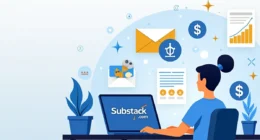Table of Contents
The application of the web refers to how we use web technologies like browsers and servers to build tools that run online. These web apps range from simple calculators in your browser to complex platforms like Gmail or Netflix. Understanding their types, trends, and uses helps you see why they matter for daily life and business.
The application of the web matters.
Web applications are everywhere, and they make life easier.
- Convenience: You can access them from any device with an internet connection.
- No installation required: Everything runs in your browser. No need to download or update software.
- Automatic updates: Web app creators make improvements without bothering you.
These benefits explain why businesses and individuals rely on web apps for productivity, shopping, education, entertainment, and more.
Types of web applications by interactivity
Here are four main types of web apps based on how people interact with them:
| Web App Type | Description | Use Cases |
|---|---|---|
| Static | No server-side logic; content stays the same | Informational sites, portfolios, and landing pages |
| Dynamic | Displays personalized content pulled from a server | Social media, YouTube, Twitter |
| Single-Page Application (SPA) | Updates content dynamically without full-page reloads | Gmail, Google Maps, Netflix |
| Progressive Web App (PWA) | It looks like an app and can work offline, with features like push alerts | Twitter PWA, Starbucks, Uber |
Common applications of the web in real life
Web apps power many daily experiences.
1. Productivity and Collaboration
Tools like Google Docs, Office Online, Trello, and Slack let teams work together in real time, all in a browser.
2. Online Shopping & E-commerce
Web apps like Amazon or eBay handle browsing, shopping carts, and secure payments all through a browser.
3. Entertainment & Streaming
Web-based apps like Netflix and Spotify stream videos and music instantly without needing desktop apps.
4. Communication & Social Media
Platforms like Twitter, Facebook, and Zoom run as web apps, offering feeds, chat, and video calls effortlessly.
5. Specialized Services
- Banking apps run online securely.
- Educational platforms like Coursera offer courses via the web.
- Booking services for travel, hotels, events, and tickets are all done online.
Latest trends in the application of web
Web app development keeps evolving rapidly in 2025.
1. AI & Machine Learning
Web apps now include AI features like chatbots and content personalization powered by systems like ChatGPT and Copilot.
2. Progressive Web Apps (PWAs)
Offering app-like experiences and offline use, PWAs are cost-effective and highly engaging.
3. Headless CMS & API-first Design
Separating backend content storage from frontend interfaces allows multi-platform delivery and flexibility.
4. Web Assembly (WASM)
Brings native-speed performance to browsers so complex apps like video editors can run online.
5. Serverless & Edge Computing
Developers can run web apps without managing servers, using functions triggered in the cloud or on the edge.
6. Voice & Visual Web Interaction
Voice search and AR/VR experiences in browsers are gaining traction for accessibility and engagement. More attention on core web vitals, HTTPS, and secure development to protect user data.
Benefits of web applications
Using web apps gives clear advantages:
- Easy access anywhere
- Low cost, no downloads or licenses needed
- Scale quickly for growing users
- Works across device types (phones, laptops, tablets)
- Always up-to-date for users without manual updates
Challenges in the world of web apps
Despite benefits, web apps face some challenges:
- Performance may slow down compared to native apps, especially with heavy code or media.
- SEO issues for SPAs unless optimized.
- Browser compatibility can be tricky across versions and standards.
- Security threats like XSS, injection attacks, and API vulnerabilities.
- Offline support remains limited for non-PWAs.
Getting started with building web apps
If you want to dive in, here are practical steps:
- Choose your type static site, dynamic site, SPA, or PWA.
- Learn core tools like HTML, CSS, JavaScript, and modern frameworks (React, Vue, Angular).
- Decide on architecture traditional CMS, headless CMS, or serverless.
- Build secure APIs and backends using Node.js, Python, or others.
- Test performance and make improvements for speed and mobile usability.
- Deploy your app using platforms like Netlify, Vercel, AWS, or Azure.
FAQ
1. What does “application of web” mean?
The term “application of the web” means how websites and web-based tools are used in our daily lives. It includes everything from checking email to online shopping and video calling.
2. What are some examples of web applications?
Some common examples are
- Gmail (for email)
- Netflix (for watching videos)
- Amazon (for online shopping)
- Google Docs (for writing and editing files online)
These apps run through your web browser.
3. Why are web applications important?
Web apps make it easy to do things online without installing software. You can use them on any device, anytime, as long as you have internet.
4. What are the main types of web applications?
The main types are
- Static (simple, fixed pages)
- Dynamic (interactive content like social media)
- Single-page apps (like Gmail)
- Progressive web apps (work offline too, like mobile apps)
5. Are web applications safe to use?
Most well-known web apps are safe if you use them on secure websites. Always check for “https://” in the address, and don’t share personal info on unknown sites.
Conclusion
The application of the web shapes how tools and services reach users today, from emailing and streaming to shopping, chatting, and advanced AI tools. Modern trends like PWAs, AI integration, WebAssembly, and serverless setups push web apps into new territory. If you’re building or using these tools, knowing their benefits, types, and future direction helps you make the most of what’s possible online.









